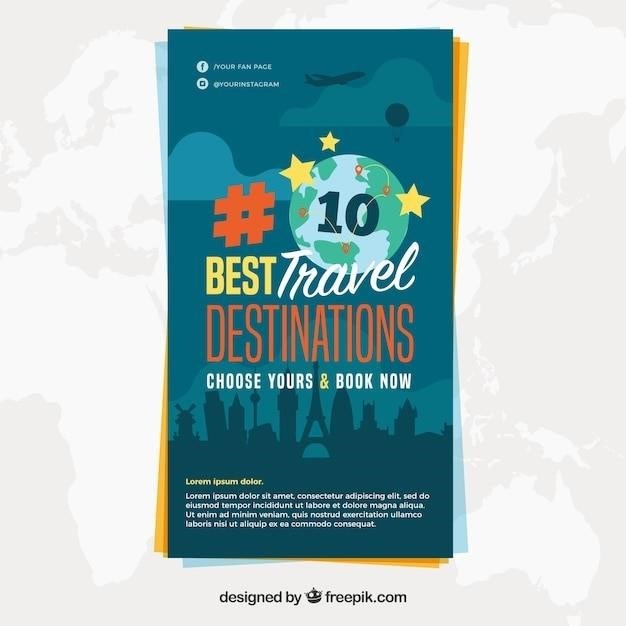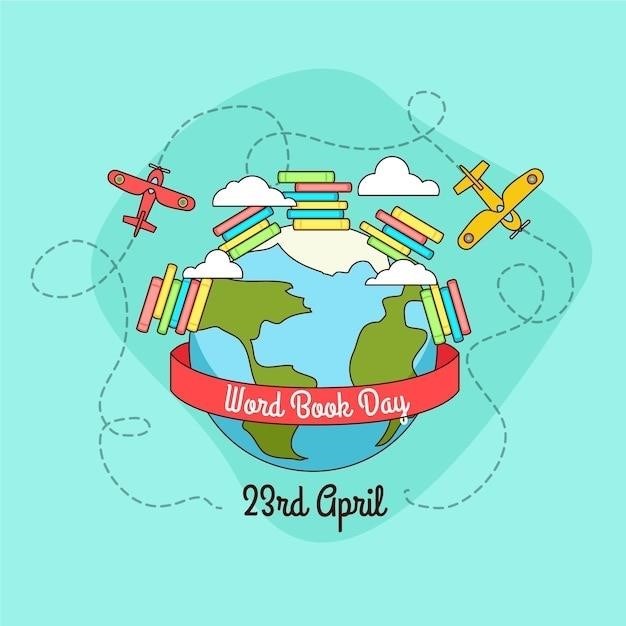Around the World in 80 Days⁚ A Comprehensive Guide to Finding the PDF
This guide helps you locate free and legal PDF versions of Jules Verne’s classic adventure novel, “Around the World in 80 Days․” Explore various online archives and eBook platforms offering downloads in multiple formats, including PDF, EPUB, and MOBI․ Discover different editions, from original translations to adapted versions․
Where to Find Free and Legal Downloads
Securing a legitimate, free PDF of “Around the World in 80 Days” might require some searching․ Public domain copies exist, meaning copyright restrictions have expired, allowing free distribution․ Websites like Project Gutenberg often host such works․ Check for these; however, always verify the source’s legitimacy to avoid malware or copyright infringement․ Internet Archive is another potential source, a digital library offering various formats, including PDFs of public domain books․ Remember to examine the file’s metadata for publisher and copyright details to ensure legality․ Some libraries provide online access to digitized books, offering PDFs or other formats for download, often requiring a library card․ Explore your local library’s online resources․ Be cautious of unofficial sources offering free downloads, as they may contain viruses or violate copyright laws․ Prioritize reputable websites and digital archives․
Accessing the Book Through Online Archives
Many online archives offer digitized versions of “Around the World in 80 Days,” often available for free download in PDF format․ The Internet Archive is a prime example; a vast digital library containing numerous public domain books․ Their search function allows you to locate various editions, potentially including different translations or illustrated versions․ Another valuable resource is Google Books, which sometimes offers full-text previews or even complete downloadable PDFs of older books․ Remember to check the copyright status before downloading to ensure legality․ University library websites often provide access to digitized collections, including classic literature․ These archives may require registration or a login, but it could offer higher quality PDFs and additional metadata․ Exploring these options expands your chances of finding a suitable PDF version of Verne’s adventure․
Exploring Different eBook Formats (PDF, EPUB, MOBI)
While PDF remains a popular choice for its widespread compatibility and ability to preserve formatting, other eBook formats offer advantages․ EPUB, a widely used open standard, adapts to various screen sizes and devices, making it ideal for e-readers and tablets․ MOBI, primarily associated with Amazon Kindle devices, provides a streamlined reading experience optimized for those devices․ The choice often depends on personal preference and the reading device․ PDFs are excellent for preserving the original book’s layout, especially important for illustrated editions․ EPUB files are generally more flexible in terms of font size and other display settings․ MOBI offers features specific to the Kindle ecosystem․ When searching online, ensure you select the format that best suits your needs and available devices․ Consider factors like annotation capabilities and compatibility with your preferred reading software․

Understanding the Book’s Content
Delve into the captivating narrative of Phileas Fogg’s daring wager and his globe-trotting adventure with Passepartout․ Explore themes of punctuality, adventure, and cultural encounters in this classic․
Synopsis⁚ The Wager and the Journey
The story revolves around the eccentric English gentleman, Phileas Fogg, and his audacious wager at the Reform Club in London․ He confidently bets that he can circumnavigate the globe in a mere eighty days․ Accompanied by his newly hired, resourceful French valet, Passepartout, Fogg embarks on an incredible journey․ Their adventure takes them across continents and oceans, encountering thrilling challenges, unexpected obstacles, and diverse cultures along the way․ The race against time is filled with suspense and excitement as they navigate various modes of transportation, including steamboats, trains, and even elephants! The narrative masterfully weaves together the thrill of the chase with insightful observations about the world’s diverse landscapes and societies of the 19th century․ Will Fogg succeed in his ambitious endeavor, or will unforeseen circumstances derail his meticulously planned itinerary? The suspense builds as the reader is swept along on this exhilarating race around the world․
Key Characters⁚ Phileas Fogg and Passepartout
Phileas Fogg, the protagonist, is portrayed as a wealthy, precise, and enigmatic English gentleman of impeccable habits and unwavering punctuality․ His calm demeanor and meticulous planning are central to his character․ He embodies the Victorian ideal of self-control and rational behavior, yet his daring wager reveals a hidden adventurous spirit․ In stark contrast, Passepartout, Fogg’s French valet, is depicted as jovial, impulsive, and adaptable․ He serves as a foil to Fogg’s reserved nature, providing comic relief and demonstrating remarkable resourcefulness in various challenging situations․ Passepartout’s enthusiastic participation in the global race highlights the unexpected camaraderie that develops between the two vastly different men․ Their contrasting personalities form the core dynamic of the narrative, creating a compelling interplay between order and chaos, precision and spontaneity, throughout their extraordinary journey around the world․
Themes Explored⁚ Punctuality, Adventure, and Culture
Jules Verne’s “Around the World in 80 Days” masterfully explores several interwoven themes․ Punctuality acts as a central motif, shaping Fogg’s character and driving the narrative’s tension․ His unwavering commitment to his schedule underscores the Victorian emphasis on order and precision․ The relentless pursuit of the wager highlights the thrilling aspects of adventure, showcasing the unexpected challenges and thrilling escapes inherent in circumnavigating the globe․ Furthermore, the novel offers a glimpse into diverse cultures through the many countries Fogg and Passepartout visit․ The descriptions of various landscapes, customs, and people expose the readers to a fascinating array of cultural experiences, highlighting both the similarities and differences between various societies․ This cultural immersion enhances the adventure narrative, enriching the overall reading experience․

Exploring Different Editions
Discover diverse editions of “Around the World in 80 Days,” ranging from simplified versions for younger readers to richly illustrated books and modern translations․ Explore the variations in artwork and textual interpretations across different published versions of this classic novel․
Adapted Versions for Different Reading Levels
Finding “Around the World in 80 Days” in a format suitable for various reading levels is crucial for accessibility․ Many publishers offer simplified versions tailored for younger readers or those with lower reading comprehension skills․ These adaptations often shorten the text, simplify vocabulary, and modify sentence structures to enhance understanding without sacrificing the core narrative․ Look for versions labeled as “easy readers,” “level readers,” or with specific reading level indicators (e․g․, Lexile or Guided Reading levels)․ These adapted editions maintain the spirit of Verne’s adventure while making it accessible to a wider audience․ They are perfect for introducing younger readers to classic literature and building their confidence and fluency․ Online retailers and libraries often categorize books by reading level, making it easier to find appropriate versions․ Remember to check reviews to see how well the adaptations preserve the original story’s charm and excitement․
Illustrated Editions and Unique Artwork
Enhance your reading experience of “Around the World in 80 Days” with illustrated editions that bring Verne’s vivid descriptions to life․ Many versions feature captivating artwork, ranging from classic line drawings to full-color paintings․ These illustrations can significantly enrich your understanding and enjoyment of the story, providing visual representations of the diverse locations, characters, and exciting events․ Some editions showcase unique artistic styles, reflecting different interpretations of the novel’s themes and atmosphere․ Searching for “illustrated editions” or specifying a preferred artistic style (e․g․, “vintage illustrations,” “watercolor illustrations”) when searching online can help you discover visually stunning versions․ Consider the artwork’s style and quality when making your choice, as it can greatly impact your overall reading experience, making the journey around the world even more immersive and memorable․
Original vs․ Modern Translations
When searching for a PDF of “Around the World in 80 Days,” you’ll encounter both original and modern English translations․ Original translations, often closer to the original French text, might employ older vocabulary and sentence structures, offering a glimpse into the language of Verne’s time․ Modern translations, conversely, aim for greater clarity and accessibility for contemporary readers, potentially sacrificing some nuances of the original phrasing․ The choice depends on your preference․ If you appreciate the historical context and linguistic richness of the original, seek out older translations․ However, if ease of reading and modern comprehension are priorities, a recent translation might be more suitable․ Be aware that different translators may have different approaches, leading to variations in tone and interpretation, even within modern translations․ Comparing reviews and sample excerpts can help you decide which translation best suits your reading style and goals․
Additional Resources
Beyond the book itself, explore Jules Verne’s biography, the historical context of 19th-century travel, and critical analyses to enrich your understanding of “Around the World in 80 Days․”
Author Information⁚ Jules Verne’s Life and Works
Jules Verne (1828-1905), a towering figure in science fiction, crafted “Around the World in Eighty Days,” showcasing his knack for adventure and meticulous detail․ Born in France, Verne’s early life laid the groundwork for his later literary achievements․ His fascination with exploration and technological advancements is evident in his prolific output․ Beyond “Around the World in Eighty Days,” Verne penned numerous other celebrated works, including “Twenty Thousand Leagues Under the Sea” and “Journey to the Center of the Earth․” These novels, characterized by their blend of scientific plausibility and thrilling narratives, cemented his place as a pioneer of the science fiction genre․ Verne’s impact extends beyond mere entertainment; his stories ignited imaginations and fueled a sense of wonder about the possibilities of scientific progress and global exploration․ His legacy continues to inspire readers and writers alike, highlighting the enduring power of his adventurous tales and imaginative worlds․ Verne’s meticulous research and attention to detail further enhance the realism and believability of his narratives․
Historical Context⁚ 19th-Century Travel and Technology
Published in 1872, “Around the World in Eighty Days” reflects the burgeoning advancements in 19th-century transportation and communication․ The novel’s narrative hinges on the feasibility of circumnavigating the globe within a specific timeframe, a feat only possible due to the era’s developing infrastructure․ Steam-powered ships and the expanding railway networks played crucial roles, drastically reducing travel times compared to previous centuries․ The book subtly highlights the limitations of these technologies as well; delays and unexpected events still occur, emphasizing the inherent challenges of such a journey․ Furthermore, the narrative touches upon the communication systems of the time, such as the telegraph, which, while nascent, allowed for rapid transmission of information across continents, playing a critical role in Fogg’s race against time․ These technological aspects are integral to the plot, placing the story firmly within its historical context and providing a glimpse into the transformative impact of technological progress on global travel during the 19th century․ Verne masterfully integrates these elements into a gripping adventure story․
Critical Analyses and Reviews of the Novel
Critical reception of Jules Verne’s “Around the World in Eighty Days” has consistently highlighted its blend of adventure, meticulous planning, and cultural exploration․ Reviewers often praise Verne’s detailed descriptions of diverse geographical locations and cultures encountered during Phileas Fogg’s journey, showcasing the author’s extensive research․ The novel’s themes of punctuality versus spontaneity, the clash between individual ambition and unforeseen circumstances, and the depiction of a rapidly changing global landscape continue to resonate with modern readers․ Some analyses focus on the character development of Fogg and Passepartout, exploring their contrasting personalities and the evolving dynamics of their relationship․ The novel’s enduring popularity is attributed to its captivating plot, memorable characters, and the timeless appeal of adventure and exploration․ Literary critics have also analyzed the novel’s underlying social commentary on Victorian society and its rapidly expanding global reach․ The book’s impact on subsequent adventure literature and its influence on popular culture are frequently discussed, solidifying its place as a cornerstone of the genre․

No Responses